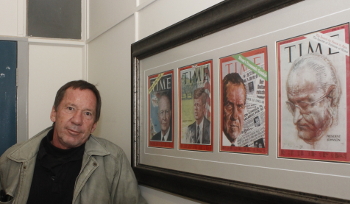Latest News Archive
Please select Category, Year, and then Month to display items
28 June 2022
|
Story Nonsindiso Qwabe
|
Photo ALBERT VAN BILJON
 In conversation: Prof Petersen and Leanne Manas.
In conversation: Prof Petersen and Leanne Manas.
An outward-looking, globally competitive university that ranks among the top-tier universities in South Africa and on the continent, driven by a strong human-centred, diverse social-justice approach. This is at the heart of the vision
Prof Francis Petersen, Rector and Vice-Chancellor of the UFS, shared with multi-award-winning
news anchor
Leanne Manas during a sit-down conversation on Friday 22 July 2022.
Prof Petersen reflected on the great strides and difficulties faced during his first term, as well as navigating the UFS through the COVID-19 pandemic to position the institution in a strategic and focused manner as a university of choice on the continent
and in other parts of the globe.
 Prof Prakash Naidoo, Vice-Rector: Operations, introduced Leanne Manas
Prof Prakash Naidoo, Vice-Rector: Operations, introduced Leanne Manas
 Prof Francis Petersen
Prof Francis Petersen
 Leanne Manas and Prof Petersen In conversation
Leanne Manas and Prof Petersen In conversation
 Leanne Manas
Leanne Manas
 Leanne Manas meeting our staff members.
Leanne Manas meeting our staff members.
 Leanne Manas meeting our staff members.
Leanne Manas meeting our staff members.
 Leanne Manas meeting our staff members.
Leanne Manas meeting our staff members.
 Prof Petersen with some of our staff members
Prof Petersen with some of our staff members
 From the left; Prof Prakash Naidoo, Leanne Manas, Prof Francis Petersen and Temba Hlasho, Executive Director: Student Affairs
From the left; Prof Prakash Naidoo, Leanne Manas, Prof Francis Petersen and Temba Hlasho, Executive Director: Student Affairs
 Leanne Manas meeting our staff members.
Leanne Manas meeting our staff members.
 From the left; Prof Prakash Naidoo, Prof Francis Petersen and Quinton Koetaan, Senior Director; HRA
From the left; Prof Prakash Naidoo, Prof Francis Petersen and Quinton Koetaan, Senior Director; HRA
 Leanne Manas meeting our staff members.
Leanne Manas meeting our staff members.
Photo manipulation in journalism: evil, crutch or lifebuoy?
2017-09-04

Albe Grobbelaar, veteran journalist and lecturer in the
Department of Communication Science at the UFS.
Photo: Rulanzen Martin
Since the 1800s the manipulation of photographs has been common practice, and who can forget the OJ Simpson Time magazine cover in 1994? Albe Grobbelaar, lecturer in the Department of Communication Science at the University of the Free State (UFS), asked in a special lecture on 18 August 2017 whether “Photo manipulation in Journalism” was an evil habit, a crutch or a lifebuoy.
“As a journalist I have always been interested in photography. And the principle of photo manipulation or tampering with photos, as we call it, is something that has interested me ever since,” Grobbelaar said. Photo manipulation is an area that has garnered many academic interest and is not a new trend but a practice that started in the 1830s when photos came into popular use. “It is not always done with ulterior motives, artists played with photographs to get unique effects.” Photo manipulation is not only to create fake news, but is sometimes used to convey novelty and create shock to news readers.
Different viewpoints for different circumstances
He talked about the spectrum of viewpoints on photo manipulation. Some conservative journalism schools say photos should never be retouched while other feel it is fine to tamper with pictures. “What I tried to convey in the lecture was that one should consider different circumstances differently,” Grobbelaar said. As a journalist he believes that news photos should never be manipulated.
He mentioned the example of the mugshot of OJ Simpson that the Los Angeles Police Department released to the media. “Newsweek and Time both used the photo on their front pages, but Time deliberately darkened the picture so that OJ, a black man, would appear more sinister,” Grobbelaar said. It is, however, common practice in the fashion industry to retouch images that are used in fashion magazines.
Use own judgment to validate photos
In the age of social media it has become easy to manipulate photos and which has been labelled fake news. “I would advise people to use their own judgment when validating the authenticity of photos,” Grobbelaar said. It is important to verify whether they are from a reliable news outlet.